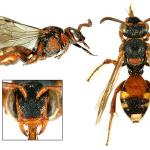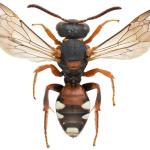Nomada roberjeotiana tormentillae ALFKEN 1901; Nomadita montana MOCSARY 1894; Nomada panzeriana WALCKENAER 1802; Nomada neglecta HERRICH-SCHAEFFER 1839
A small Nomada in which the gaster is mainly red with a pair of lateral yellow spots on gastral tergites 2 and 3; scutellum red.
A rare species but widely distributed in Britain, the range extending from southern England north to southern Scotland. It has also been recorded from the Isle of Man (Nelson, 1958) but not the Channel Islands. There is no confirmed record from Ireland. Its appearance is irregular, being apparently subject to extreme fluctuations of scarcity and abundance. For example, in the period 1970-73 G M Spooner found the bee to be unexpectedly numerous in several sites in Devon and Cornwall (many specimens from these were donated by him to The Natural History Museum, London). Overseas, a northern bee, becoming sporadic further south in central Europe; it is also known from Japan.
Not listed in Shirt (1987), but given as Rare (RDB3) by Falk (1991).
Mainly lowland heaths in southern England, and moorland in the south-west and north.
Univoltine; end of June to late August.
Cleptoparasitic on Andrena tarsata (Perkins, 1919). G M Spooner observed females in the vicinity of the nest burrows of this species in the West Country (Spooner Collecting Diaries (unpublished) in The Natural History Museum, London).
Associated mainly with tormentil (Potentilla erecta) (which is also the main forage species of A. tarsata); occasionally on ragwort (Senecio jacobaea).
None known.
Profile written:
Updated: 22/12/2011



